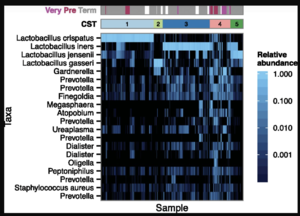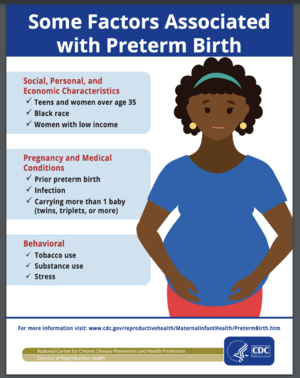The Role of the Vaginal Microbiome in Preterm Birth
Introduction: Preterm birth
Preterm birth (PTB) is the delivery of newborns before the 37th week of gestation, with most preterm births (>80%) occurring between 32 and 37 weeks. [1] Globally, rates of preterm birth range from 5-18% for 184 countries, amounting to 15 million babies born prematurely each year. [1] In America, preterm birth accounts for 11-12% of American pregnancies [2] [3] but with marked disparities in race, occurring in 17.8% of births in African Americans. Both the rates for the United States and the world have been increasing for the past several decades. [2][1][4] In the United States, incidence of preterm birth increased 30% from 1981 to 2010. [1]
Causes of Preterm Birth
There are two main types of preterm labor: providor-initiated birth, involving elective Cesarean section or induction of labor before term, and spontaneous. The majority (70–75%) of all preterm births are spontaneous [6]. Prior to about 30% of sPTBs, the fetal membranes rupture, known as preterm prelabor rupture of membranes (PPROM) [7]
The causes and mechanisms of spontaneous PTB are not fully understood; in as many as half of all spontaneous preterm births, the cause remains unknown. Many risk factors have been identified, and preterm birth is likely caused by an interplay of them (Figure 1)[1].
Some risk factors include environmental effects such as exposure to air pollution [8], and identity factors including education level [6], socioeconomic status, and maternal age (those younger than 18 or older than 35 have higher risk). Race and ethnicity also play a big role in risk of preterm birth. In 2021, rates of preterm birth were 50% higher for Black women than white women [5]. Maternal health is very important, with inadequate nutrition [9], and unhealthy Western-style diets [10], low or high Body Mass Index (BMI), diabetes, chronic hypertension, metabolic and genetic disorders, and other underlying diseases increasing risk of preterm birth 10. Lifestyle risk factors include excessive physical work or long times spent standing, stress, smoking, alcohol, and drug use during pregnancy, [1]. Additionally, factors relating to the pregnancy, including inadequate prenatal care, multiple gestations (twins, triplets, ect), primiparity (the number of offspring female has borne), and short intervals of time between pregnancies, increase risk of preterm birth [6], 10. The role of infection in preterm birth is being investigated, as intra-amniotic infection is present in one-third of spontaneous preterm births [6], including malaria, syphilis, HIV, urinary tract infections, and bacterial vaginosis [1].
Effects of Preterm Birth
The effects of preterm birth are wide-ranging. Babies born prematurely have much higher incidence of disease and death, especially in the month following birth, known as the neonatal period [6]. Preterm birth directly causes 35% of all neonatal deaths [1]. One reason for this is that babies born before term usually do not have fully developed hearts or lungs, resulting in respiratory and cardiovascular complications that often lead to death [6]. Preterm birth also indirectly increases risk of death from other factors, especially infection [1]. Collectively, preterm birth is the leading cause of neonatal death [3], contributing to around 80% of perinatal mortality 10.
Even if the baby survives the first month, it will likely face many challenges. 50% of neurologic problems reported in this period can be traced to preterm birth 10. Furthermore, complications, including difficulty gaining weight in infancy [1], and aforementioned respiratory and cardiovascular disorders, continue to lead to mortality in early childhood. Worldwide, complications from preterm birth remain the leading cause of death for children under five [7], amounting to over 1 million deaths a year [1].
Those that survive into adulthood can suffer many significant, long-term impacts, including neuro-developmental and behavioral effects such as anxiety, depression, ADHD, executive functioning disorders, dyslexia, learning disabilities, cerebral palsy, and motor and sensory deficits. Hearing impairment and visual impairment including blindness, myopia, and hypermetropia are also frequent, as well as accelerated adolescent weight gain. Cardiovascular and Respiratory disorders can continue to cause problems, including increased blood pressure and chronic lung disease sometimes leading to a requirement for home oxygen [7] [1].
These effects can all have emotional and economic impacts on the family [1], as well as leading to significant socioeconomic loss later in life [6]. In addition to socioeconomic loss for individuals, preterm birth incurs high societal costs, estimated at $26.2 billion yearly [4][2][1].
Vaginal Microbiome
The vaginal canal, and indeed the entire human body, is colonized by diverse microbiota, which both shape and respond to the host environment 9. Most microbes are not pathogenic, and instead exist in a mutualistic relationship with their human hosts, playing significant roles in immune programming, nutrient acquisition, and protection against pathogens 9. Microbiomes vary greatly between individuals and over time based on genetics and environmental exposures 9, 11
Traditionally, it was believed that a “healthy” vaginal microbiome is dominated by Lactobacillus bacteria, which produce lactic acid through anaerobic respiration, keeping vaginal pH between 3.5-4.5 8. The low pH, competition for space and resources, and the production of bacteriostatic and bacteriocidal compounds helps prevent infections including urinary tract infections, yeast infections, sexually transmitted infections, and HIV infection 11. Historically, any microbial composition not dominated by Lactobacillus has been deemed not only “unhealthy,” but indicative of a disorder, Bacterial Vaginosis (BV), which is characterized as a “community-wide alteration of the vaginal microbiota” 11 or “the disruption of the equilibrium of the normal vaginal microbiota” 8. The diagnosis of BV is somewhat subjective 8, but it typically depends on clue cells, vaginal pH greater than 4.5, and profuse vaginal discharge that has a “fishy odor” when exposed to potassium hydroxide 5, 8. In laboratories and research, a Nugent gram stain score is used for diagnosis, which is generally considered to be more accurate. It assigns numerical values based on bacterial composition, assigning low numbers for Lactobacillus, and higher numbers for other bacteria, with higher results indicating BV 8.

However, infectious diseases depend as much on the host response as the microbial invasion 13, and this process of diagnosing BV does not consider the host response. In fact, although the vagina is capable of mounting an inflammatory immune response, as evidenced by its reactions to Trichomonas vaginalis and Candida, BV is not typically associated with any signs of inflammation. Indeed, it has been found that 50% of BV cases are asymptomatic 13, and attempts at treatment are usually unsuccessful, with a high rate of recurrence 13.
Further research has characterized the vaginal microbiomes into five Community State Types (CSTs) based on their microbiota composition. Four of the five (CST 1, 2, 3, and 5) are colonized primarily by different varieties of Lactobacillus, while CST 4 is characterized by low levels of Lactobacillus and a diverse array of other anaerobic bacteria 8, 9, 11. Interestingly, ethnicity appears to play an important role in microbiome composition, as Black and Hispanic women are more likely to have CST 4 microbiomes, and white and Asian women more likely to have Lactobacillus dominated microbiomes 8.
Although CST 4, and the microbiomes of Black and Hispanic women, are associated with a higher pH on average, and (perhaps therefore) a greater susceptibility to infection than Lactobacillus dominated microbiomes, at least half the women with this more diverse microbiomes seem to be otherwise healthy 13. The diagnosis of the infectious disorder Bacterial Vaginosis, which is considered “abnormal” and “unhealthy” depends in large part on the proportion of bacteria that is found less often in Black and Hispanic women, many of whom seem to be “normal” and “healthy” without this bacteria. It appears that BV is overdiagnosed, and what is considered “normal” and “healthy” needs an overhaul. 8, 11, 13
The Role of the Vaginal Microbiome in Preterm Birth
Bold
Italic
Subscript: H2O
Superscript: Fe3+
References
- ↑ 1.00 1.01 1.02 1.03 1.04 1.05 1.06 1.07 1.08 1.09 1.10 1.11 1.12 1.13 World Health Organization. (2012). Born too soon: the global action report on preterm birth.
- ↑ 2.0 2.1 2.2 Hyman, R. W., Fukushima, M., Jiang, H., Fung, E., Rand, L., Johnson, B., ... & Giudice, L. C. (2014). Diversity of the vaginal microbiome correlates with preterm birth. Reproductive sciences, 21(1), 32-40.
- ↑ 3.0 3.1 3.2 DiGiulio, D. B., Callahan, B. J., McMurdie, P. J., Costello, E. K., Lyell, D. J., Robaczewska, A., ... & Relman, D. A. (2015). Temporal and spatial variation of the human microbiota during pregnancy. Proceedings of the National Academy of Sciences, 112(35), 11060-11065
- ↑ 4.0 4.1 White, B. A., Creedon, D. J., Nelson, K. E., & Wilson, B. A. (2011). The vaginal microbiome in health and disease. Trends in Endocrinology & Metabolism, 22(10), 389-393.
- ↑ 5.0 5.1 CDC Preterm Birth | Maternal and Infant Health | Reproductive Health | CDC. (n.d.). https://www.cdc.gov/reproductivehealth/maternalinfanthealth/pretermbirth.htm.
- ↑ 6.0 6.1 6.2 6.3 6.4 6.5 6.6 Park, S., You, Y. A., Kim, Y. H., Kwon, E., Ansari, A., Kim, S. M., ... & Kim, Y. J. (2022). Ureaplasma and Prevotella Colonization with Lactobacillus Abundance During Pregnancy Facilitates Term Birth.
- ↑ 7.0 7.1 7.2 Brown, R. G., Marchesi, J. R., Lee, Y. S., Smith, A., Lehne, B., Kindinger, L. M., ... & MacIntyre, D. A. (2018). Vaginal dysbiosis increases risk of preterm fetal membrane rupture, neonatal sepsis and is exacerbated by erythromycin. BMC medicine, 16(1), 1-15..
- ↑ Trasande, L., Malecha, P., & Attina, T. M. (2016). Particulate matter exposure and preterm birth: estimates of US attributable burden and economic costs. Environmental health perspectives, 124(12), 1913-1918.
- ↑ Wang, Z., Zhao, S., Cui, X., Song, Q., Shi, Z., Su, J., & Zang, J. (2021). Effects of dietary patterns during pregnancy on preterm birth: a birth cohort study in Shanghai. Nutrients, 13(7), 2367.
- ↑ Chia, A. R., Chen, L. W., Lai, J. S., Wong, C. H., Neelakantan, N., van Dam, R. M., & Chong, M. F. F. (2019). Maternal dietary patterns and birth outcomes: a systematic review and meta-analysis. Advances in Nutrition, 10(4), 685-695.
Edited by [Elianajoy Volin], student of Joan Slonczewski for BIOL 116 Information in Living Systems, 2022, Kenyon College.

